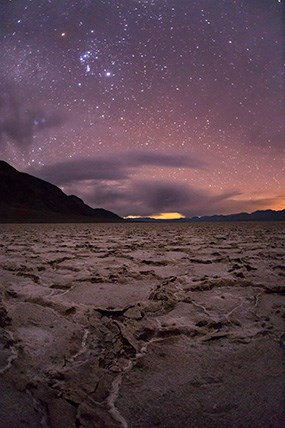
NPS/Dan Duriscoe International Dark Sky ParkDeath Valley National Park has some of the darkest night skies in the United States and was the third International Dark Sky Park in the U.S. National Park System certified by the International Dark-Sky Association. To qualify for the dark sky designation, the park improved exterior lighting at facilities in the Furnace Creek and Stovepipe Wells areas, reducing energy consumption, sky glow, and glare. The designation requires the park to maintain its efforts to protect night sky resources and provide visitor education on dark skies. Light PollutionAs urban areas grow and the use of artificial outdoor lighting increases, night skies brighten and stars fade from view. Most people can't see the Milky Way from where they live and they may never see it in their lifetime! Luckily, places such as Death Valley National Park have worked hard to protect darkness for all to enjoy. 
NPS Protecting Darkness in Death ValleyDeath Valley National Park’s remote location has allowed it to continue to have dark night skies, but there are multiple developed areas within the park which must be lit to ensure that people can safely navigate around facilities. In the past, light in these areas was used improperly and created light pollution, decreasing visitor enjoyment of the night sky. Today, the park follows strict lighting guidelines to minimize the impacts of artificial lighting. Protecting Darkness in National ParksMore and more parks are rethinking their lighting and are making efforts to protect night sky viewing opportunites for the public. Over 30 U.S. national parks and monuments have earned the International Dark Sky Park designation and others are working to join them. Find a Dark Sky location near you. Check out the articles listed at the bottom of the page to learn more about dark sky research and visitor support for protecting dark skies in national parks and monuments across the country. 
Tyler Nordgren Protecting Darkness at Home"At Death Valley the sky literally begins at your feet," said Tyler Nordgren, Associate Professor of Physics at the University of Redlands (Calif.) and International Dark-Sky Association board member. "When my students and I look up at night from our southern California campus, we can usually count 12 stars in the sky. However, less than a five hour drive from Los Angeles there's a place where anyone can look up and see the universe the way everyone could 100 years ago."
Explore Darkness in Death Valley National ParkHalf the park is after dark, so be sure to take advantage of Death Valley's dark skies and stay after sunset. Experiencing night in the park can be as simple as finding a quiet place to look up and enjoy the stars.
Articles about Dark Sky Research and Support for Dark Skies |
Last updated: February 25, 2024
